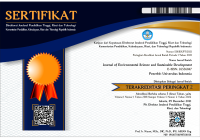Abstract
The current trend in nature tourism has led to increased tourist visits to coastal areas, including destinations prone to disasters and previously exposed to tsunamis. This research, which aims to analyze the variables influencing tourists' desire to revisit disaster-prone areas, addresses a crucial and timely topic in tourism and disaster management. The research utilized a quantitative approach through a questionnaire-based survey of domestic tourists visiting the Pangandaran Beach Area in West Java, known for its susceptibility to tsunami disasters. The study involved 307 respondents who completed questionnaires between June and July 2023. Data analysis employed Partial Least Square – Structural Equation Model (PLS-SEM) analysis. The findings indicate a moderate level of association among the variables studied, with an R2 coefficient of 0.521. This suggests that destination image, risk perception, regional attractiveness, and knowledge of disaster risks collectively influence tourists' intentions to revisit. Notably, the variable "knowledge" did not significantly impact destination image and revisit intention but did influence risk perception. Additionally, risk perception was identified as a determinant influencing tourists' decisions to revisit Pangandaran. The research underscores the critical role of risk perception in influencing tourists' behavior in disaster-prone areas. This research highlights educating tourists about disaster risks and integrating individual factors in planning, as both influence revisits to disaster-prone destinations.
Recommended Citation
Rahmafitria, Fitri; Diyah Setiyorini, Heri Puspito; Hindayani, Purna; and Ramadhan, Andrian
(2024).
THE ROLE OF DESTINATION IMAGE AND RISK PERCEPTION ON INTEREST IN REVISITING DISASTER-PRONE COASTAL DESTINATIONS.
Journal of Environmental Science and Sustainable Development, 7(1), 480-495.
Available at: https://doi.org/10.7454/jessd.v7i1.1227






